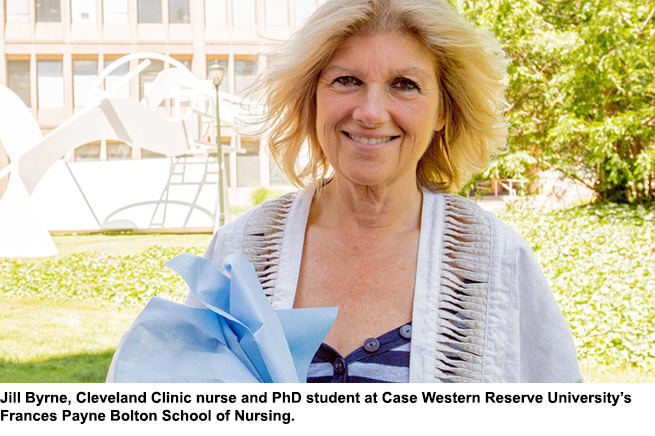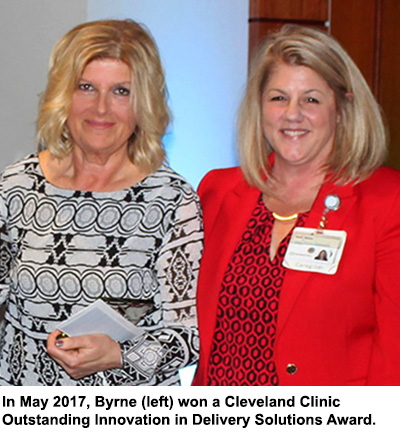Garment reduces heat stress, an occupational hazard.

As an operating room nurse, Jill Byrne saw how heat shortened the tempers and focus of stressed, sweating surgeons.
When even brilliant and confident surgeons look like they’ve been in a dunk tank, you worry about their discomfort,” says Byrne, a PhD student at Case Western Reserve University’s Frances Payne Bolton School of Nursing and Cleveland Clinic nurse for 31 years.
So Byrne set out to create a garment that could help reduce heat stress.
Working in her living room, she fashioned a vest from scrap draping material common in hospitals. Outfitted with pockets for refreezable ice packs placed around the body, the garment was designed to fit under a surgical gown.
The first surgeon who wore the cooling vest showed such a dramatic change in personality, Byrne says, that he sang show tunes and was calm, polite, and clear of mind during the procedure.
“So I started sewing more,” she says. “Dozens of surgeons started using them.”
Byrne’s push to commercialize the vest was rejected at first, but she persisted. She returned to school for her master’s degree, paving the way for her later research on heat stress and its damaging effects on physical and mental performance.

Heat stress is an occupational hazard for surgeons. They must keep the thermostat in operating rooms above 68 degrees—a standard set by the Center for Medicare & Medicaid Services—and that’s before factoring in warmth from lights, impervious layers of protective clothing, and the intense physical demands of some surgeries, such as joint replacements.
As little as 30 minutes of overheating starts to tax internal organs and is associated with weight gain, hypertension, cardiovascular disease, and impaired cognitive performance, according to peer-reviewed research and stress studies by the Mayo Clinic.
“When surgeons are wrapped in plastic to protect them from bloodborne pathogens, body heat can’t escape. The microclimate inside the gown is not only making them miserable, it’s hurting them,” says Byrne, who is dedicating her PhD thesis at the nursing school to the relationship between body temperatures of medical caregivers and their cognitive performance. “There’s such a need for this research because you have brilliant medical minds putting their own health at risk during extremely delicate tasks to improve or save lives.”
Byrne eventually made more than 500 vests on her own time and dime because she would hear and see the difference the vests made for surgeons.
Encouraged by the feedback, Byrne checked back in with the innovations department at Cleveland Clinic.
Sarah Stamp, general manager of operations and administration at Cleveland Clinic Innovations, considered the vest a novel product that could potentially fill a previously unknown market need.
In a product trial at several Cleveland Clinic facilities, 97 percent of the surgeons, technicians, and nurses said they would wear it again; they lauded the vest for its low cost and light weight. Because the vest is disposable, it does not create an additional source of contamination or laundry.
Having since secured a provisional patent, Byrne and a team from Cleveland Clinic Innovations is now working on licensing the intellectual property to a third-party manufacturer, and the vest could be for sale within a year. Because it does not come in contact with patients, the vest is not subject to regulatory approvals that can mire new inventions.
In May 2017, Byrne won a Cleveland Clinic Outstanding Innovation in Delivery Solutions Award.
“Jill didn’t give up, because she wants surgeons to be operating at tiptop shape,” Stamp says. “While her nurturing nature makes her a great nurse, her patience and passion make her the epitome of an inventor.”
Heat stress is not unique to hospital settings. Byrne wants to adapt her design for other uses and occupations. A cooling vest she made for her grandson to wear in the dugout between innings lessened his lethargy during and after Little League games, she says.
Meanwhile, she’s started her second year as a PhD candidate at the nursing school.
“I am thankful for how things are coming together,” Byrne says. “But in some ways, I feel like I’m just getting started.”
RNL
Source: Case Western Reserve University.